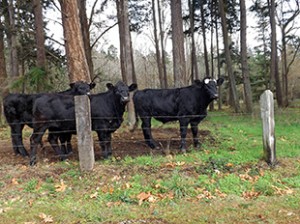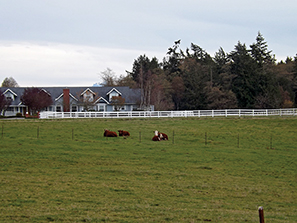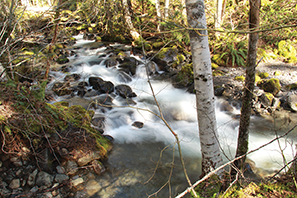Freshwater shorelines are unique ecosystems that can provide important wildlife habitat and water quality benefits, as well as enjoyment for people. As a Shore Steward, it is important to protect these valuable ecosystems that feed into our bays and inlets. Within this guideline you will learn how to protect your lake or stream.
Words to Know:
Riparian zone: the interface between land and a river or stream.
Riparian habitat: wildlife habitat found along the banks of a river, stream, or lake, and may be home to a wide range of plants, insects, birds and amphibians.
In this Guideline:
-
References for Guideline 6
-
Streamside Planting Guide for Western Washington, Jeannie Udd, 25 p, Harza Northwest Inc, Cowlitz Conservation District, Pierce Conservation District.
Taking Care of Streams: A Landowner’s Guide to Riparian Areas, Brochure, Pacific Northwest Extension, 2002.
Taking Care of Streams: A Recreationist’s Guide to Riparian Areas, Brochure, Pacific Northwest Extension, 2002.
Tips on Land and Water Management for Small Farm and Livestock Owners in Western Washington, 11 p, King Conservation District, 2005.
Best Management for Owners of Small Scale and Livestock Farms, 32 p, Skagit Conservation District, 2001.
The Washington Lake Book – A Handbook for Lake Users, Washington State Lake Protection Association, 40 p, Washington State Dept. of Ecology PUB 97-10, June 1995.
-
Living with Lakes
-
If you live on or near a lake, you are probably already aware of the unique joys and challenges of lakeside living. Whether you enjoy your lake by swimming, boating, fishing or watching birds, everything depends on the health of your lake and good water quality. Unlike rivers or streams, lakes are often calm or have slow moving water that stays in lake for a long time. This presents unique challenges for homeowners, but there is plenty that lakeside Shore Stewards can do to keep their lakes clean and healthy.
Many of the over-7,800 lakes in our state were created around 11,000 years ago when the glaciers from the last ice age retreated north of the Canadian border. The glaciers formed lake basins by gouging and piling loose soil and bedrock, burying ice chunks that melted to form lake basins, or depositing gravel and boulders across stream beds, damming the water and forming lakes. Lakes constantly evolve, reflecting changes in their watersheds, whether natural or man-made. They are all filling slowly with decaying plant materials, as well as soil washed in by floods and streams. These gradual changes affect the succession of plant and animal communities, but dramatic changes can be made in just a few years as a result of human activities.
Although many of our lakes have fairly good water quality, some lakes may be getting too many nutrients. This often occurs due to fertilizer use, failing septic systems, or pet waste left on the ground, all of which can get carried into lakes with water running off the landscape. Some nutrients also get into lakes once they soak into the ground near the lake, such as when too much fertilizer is used and even from properly functioning septic systems, since they are not typically designed to remove all the nutrients. These additional nutrients fertilize lake plants and algae. While some algae is important to the health of all lakes, providing food and energy to fish and other lake organisms, too much algae can actually harm fish and freshwater organisms and is undesirable to recreational users. There are some algae species, like blue-green algae, that produce toxins as well. The regular occurrence of algal blooms may indicate that the levels of phosphorus or nitrogen are too high. If the scums appear near the shoreline, and the toxin levels are dangerously high, local health departments will close the lake to recreation until the danger is passed or advise people (and pets) to stay out of the water.
While most of the tips and guidelines in this booklet apply to living on or near a lake. lakeside dwellers need to take special care to:
-
Use organic or slow-release fertilizers on your lawn, or use none at all. Abide by the label recommendations for application amounts, and be sure not to use immediately before predicted rain.
-
Shrink your lawn by adding native plant gardens. Less lawn means less maintenance, watering, mowing, fertilizing, and expense. More rain will soak into the ground instead of running off into the lake. Geese love large lawns, so reducing your lawn may also mean less geese.
-
Plant a buffer of native plants and vegetation between your lawn and your lake, using the right plants for the site. This will help decrease run-off from your property, and also make it less attractive to nuisance geese.
-
Landscape to slow rainwater run-off between your house and the lake. Make it easier for water to soak into the ground by placing small swales where water will naturally drain off your property, taking caution that it does not flow over a bluff, which could cause erosion or landslides. Create twists in your driveways or paths.
-
Plant a rain garden, which will help prevent excess nutrients and contaminants from flowing into the lake.
-
Consider removing your bulkhead, if you have one, or developing your property without the installation of bulkheads, which cause erosion below the waterline and eliminate habitat for juvenile Chinook salmon. Retain native vegetation whenever possible, which provides food and habitat for birds, animals and fish.
-
Practice natural yard care to protect water quality by using compost to build healthy soil, and watering the right amount and only when necessary. Seek natural alternatives to pesticides.
-
Maintain your septic system, since failed septic systems can cause significant water quality problems for lakes. Get regular inspections by an experienced professional.
-
Never dump aquarium contents, fish, or amphibious animals into the lake. These can quickly multiply, creating serious negative impacts to lake ecology.
-
Clean up pet waste promptly, as it can run off when it rains, contributing significant fecal contamination to your lake.
-
Learn to identify the noxious weeds around or in your lake. Some to watch for include Eurasian watermilfoil, purple loosestrife, fragrant water lily, yellow flag iris, and Brazilian elodea. Find out what you can do to eradicate and control them before it becomes a problem, and notify your county’s noxious weed coordinator if it does.
If you are doing any construction or lake management activity, including aquatic plant control, you may be required to obtain one or more special permits. Check into this with your local planning department early in your planning stages to avoid violation of federal, state or local laws. See Guideline 10 for additional information on permits.
Everyone around your lake has a stake in the health of the lake. Working together will benefit everyone. Consider joining your lake association or homeowners association, to work together on common objectives and goals. Working with neighbors and other property owners around your lake, and understanding how your lake works, will help you protect it.
-
-
Raising Livestock
-
 Cattle and other livestock with access to streams, lakes, or wetlands deposit manure into the water or onto nearby land, which runs off into the streams and lakes during rain events. Manure can contaminate waterways with bacteria, viruses, parasites, and other pathogens. Livestock that congregate near streams often strip stream banks of vegetation causing stream bank instability and erosion. Stream channels start to widen because there’s nothing to hold the bank in place. Livestock like to be near streams because it’s less distance for a drink of water and it’s often cooler. Thus they tend to overgraze near streams, turning the area into a mud pit during the winter, increasing erosion and providing little in the way of feed.
Cattle and other livestock with access to streams, lakes, or wetlands deposit manure into the water or onto nearby land, which runs off into the streams and lakes during rain events. Manure can contaminate waterways with bacteria, viruses, parasites, and other pathogens. Livestock that congregate near streams often strip stream banks of vegetation causing stream bank instability and erosion. Stream channels start to widen because there’s nothing to hold the bank in place. Livestock like to be near streams because it’s less distance for a drink of water and it’s often cooler. Thus they tend to overgraze near streams, turning the area into a mud pit during the winter, increasing erosion and providing little in the way of feed. The responsible management practice is to fence animals away from streams and waterbodies, providing an adequate riparian buffer zone to protect water quality. Fences can range from multi-strand, high-tensile fences that can be electrified to more robust woven wire fencing. For interior paddock fences, animals accustomed to electric fences can often be controlled by a single strand of wire. When placing fencing consider the animal species, the number of animals, vegetation density, and slope. Another benefit of keeping livestock out of streams is that it reduces the risk of disease from hoof-rot and waterborne bacteria, and provides firm footing to reduce the chance of leg injury. Fencing strategies that include rotating livestock from pasture to pasture, preventing overgrazing and allowing for quicker regrowth of moderately grazed areas can also create more productive pastures.
The responsible management practice is to fence animals away from streams and waterbodies, providing an adequate riparian buffer zone to protect water quality. Fences can range from multi-strand, high-tensile fences that can be electrified to more robust woven wire fencing. For interior paddock fences, animals accustomed to electric fences can often be controlled by a single strand of wire. When placing fencing consider the animal species, the number of animals, vegetation density, and slope. Another benefit of keeping livestock out of streams is that it reduces the risk of disease from hoof-rot and waterborne bacteria, and provides firm footing to reduce the chance of leg injury. Fencing strategies that include rotating livestock from pasture to pasture, preventing overgrazing and allowing for quicker regrowth of moderately grazed areas can also create more productive pastures.Providing an alternative source of water, as well as providing shade, salt, and supplemental feed in a location away from a stream or lake, will help keep livestock out of the water. Watering troughs that mechanically or electrically pump water from the stream or lake are available. They provide water for the livestock while protecting stream or lake banks and keeping manure a safe distance from the waterbody. Check with your conservation district about the options. Stream crossings are sometimes required to provide livestock access to pastures on the other side of the stream. A stable, firm crossing will reduce access to the stream and provide solid footing for the livestock. Grazing near riparian areas should be very limited during the dormant fall and winter seasons.
Refer to Guideline 1 for how to manage livestock waste.
-
Recreating with Nature in Mind
-
When we recreate in and along streams, rivers, and lakes, we may trample stream banks and damage the plants that are vital to fish, wildlife and water quality. Plants can be damaged and eliminated through trampling, soil compaction, and even by dogs fetching sticks. Noxious weeds, which compete with native plants, can be spread via the soles of boots, tire treads, and boat propellers and trailers.
Protect riparian habitat and water quality in streams, lakes and rivers by:
- Keeping all animals, including pets and pack animals, out of streams, wetlands, and lakes can prevent fecal matter from entering the water and reduce the amount of damage caused to riparian plants.
- Use official access points to prevent damage to shoreline plants and stream banks.
- If you fish, do not release leftover bait into the water; use it or dispose of it properly. If you get a hook caught and need to cut your line, try to remove and properly dispose of as much of the fishing line as possible.
- Clean all of your gear when moving between water bodies, including your boots and boat. This can help prevent the spread of invasive species.
If you are using a motorized boat, please refer to Guideline 7 for proper care and use.
-
Following Permitting Procedures
-
Permitting for streamside and lakeside properties may differ from those that are located along a marine shoreline. An overall review of permitting procedures is covered in Guideline 10. One difference between streamside and marine shoreline properties is the width of the buffer required. In most cases, stream buffers are measured horizontally from the edge of the ordinary high water mark (OHWM) or top of the stream back if the OHWM cannot be determined. The setback may differ significantly in different counties and cities since they each have their own regulations. It is best to check with your local planning department to determine this information, and anything else that is required by your local government’s Critical Areas Ordinance (CAO) or the Shoreline Master Program, which covers marines shorelines, larger streams, wetlands, and lakes.
When applying for a permit to do work in or along a stream or lake, you may also need to go through the Washington Department of Fish and Wildlife’s Hydraulic Project Approval (HPA) process. Thousands of HPAs are issued each year for activities ranging from work on bulkheads, piers, and docks to culvert replacement and mineral prospecting. WDFW administers the HPA program under the state Hydraulic Code, designed to protect fish life. WDFW Habitat Biologists are available to help people and groups apply for an HPA and ensure their projects meet state conservation standards for aquatic life. If you are unsure whether you need an HPA for your project you can contact a WDFW Habitat Biologist in your area for help.
The state’s Hydraulic Code Rules (Chapter 220-110 WAC) identify projects and activities that require an HPA, ranging from bulkhead construction to mineral prospecting. Refer to Guideline 10 for a list.
-
The Importance of Streamside Plants & Trees
-
 The area alongside a stream or river is referred to as a riparian zone. Plants growing along the banks are called riparian vegetation, which is primarily made up of water loving plants. Riparian zones are sometimes called buffers since they help filter pollutants out of water flowing across the landscape towards waterways. Riparian buffers areas may be natural or engineered for restoration or soil stabilization.
The area alongside a stream or river is referred to as a riparian zone. Plants growing along the banks are called riparian vegetation, which is primarily made up of water loving plants. Riparian zones are sometimes called buffers since they help filter pollutants out of water flowing across the landscape towards waterways. Riparian buffers areas may be natural or engineered for restoration or soil stabilization.One of the most important functions of riparian vegetation is its ability to control erosion and prevent sediment pollution in the stream. Increased sediment and silt in stream water can clog fishes’ gills, bury their eggs, cover their food sources on the stream bottom, and cloud the water, shading out the sun needed for aquatic life. Vegetation on the shoreline, combined with the meandering curves of the stream or river, helps dissipate stream energy, resulting in less soil erosion and flood damage.
Shoreline and overhanging vegetation provides habitat that supports microbes, stream insects, and other food sources for fish and other aquatic life. The shading effect of vegetation also helps keep water temperatures cool, which is necessary for salmon to reproduce and thrive. Fallen trees and branches in streams can also provide pools and hiding areas for juvenile fish and other aquatic life.
Shoreline vegetation also provides a natural biofilter that helps reduce pollution in surface runoff and shallow groundwater. Plants take up nitrogen and phosphorous from fertilizers and animal waste. This helps prevent algal blooms, which consume oxygen in the water (when they naturally die off) that is essential for the health of fish and other aquatic organisms.
In many cases, clearing along our streams and waterways has come too close to our waters, which warrants an increase in the buffer width of natural vegetation. In general, studies show that buffers along ditches and streams trap eroded soils, filter pollutants such as fecal bacteria from pets and livestock, and can provide wildlife corridors. The National Marine Fisheries Service offers recommendations for buffer widths based on stream type. In general:
- For man-made ditches and streams without anadromous fish (i.e. salmon), minimum buffer widths of 35’–50’ are recommended
- For fish-bearing streams, minimum buffer widths of 100’ are recommended, and
- For fish-bearing tidal streams, minimum buffer widths of 35’–75’ are recommended.
Local regulations and site conditions vary and some sources of financial assistance for installing a vegetation buffer may include specific buffer width requirements. For more detailed guidance and assistance please contact your local Conservation District or Planning Department.
- Test
-
Test
Spotlight
Resources
Better Ground Program, Snohomish Conservation District